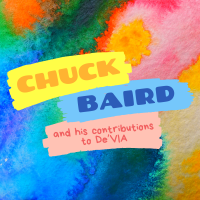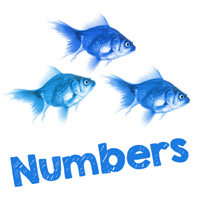
Signs That Are Close... But Not the Same — Animals
This article is part of our “Signs That Are Close... But Not the Same” series, which highlights signs that look similar, but have different meanings.
The ASL signs shown below look similar, but are not the same. There are many ASL signs that when produced look similar, but in fact have a completely different meaning. Below you will find examples of such signs. Watch closely to see if you can see the differences. In addition, watch my eyebrows, look to see when I tilt my head or lean my body in a certain way, even what my mouth is doing. These nuances are called inflections and trust me, inflections matter.
These examples are all signs related to animals.
1. Animal vs. Have vs. Vacation vs. Day Off
ANIMAL, HAVE, VACATION, and DAY OFF are all signed with the hands at the chest and use similar looking handshapes.
ANIMAL and HAVE use the same bent open B handshape, palm orientation, location, and movement with the only difference being that ANIMAL taps twice and HAVE taps once.
VACATION and DAY OFF use the same open 5 handshape, palm orientation, location, and movement with the only difference being that VACATION taps twice and DAY OFF taps once. How can you remember the difference between the two? Think of DAY OFF tapping only once because it is a single day, while a VACATION (hopefully!) is for multiple days.
- ANIMAL: With this sign, the fingertips touch the chest just under the shoulders and push inward to the chest two times.
- HAVE: This sign is the same as ANIMAL but taps only one time.
- VACATION: This sign has the thumbs of both hands tap just above the armpits two times. NOTE: The signs for VACATION and HOLIDAY are not "close but not the same," because they are actually the same!
- DAY OFF: This sign is the same as VACATION but taps only one time.
 |
||
2. Horse vs. Rabbit vs. Cow
HORSE, RABBIT, and COW all have the dominant hand at the side of the head near the temple. However, each sign uses a different hand position.
- HORSE: This sign has the thumb touching the dominant side of the head, palm facing forward in the open U handshape. The index and middle finger bend forward two times. Think of how the ears of a horse move.
- RABBIT: This sign is very similar to HORSE, using that same dominant hand in the open U handshape, but the hand is facing backward to sign RABBIT with the pinky side of the hand touching the head. The index and middle finger bend down two times, and they are facing backward.
- COW: This sign uses the Y handshape with the dominant hand facing forward, and the thumb placed on the side of the head. The extended pinky finger turns inward twice. You may think of the horns on a cow.
 |
||
3. Cow vs. Buffalo vs. President vs. Deer vs. Moose
The signs for COW, BUFFALO, PRESIDENT, DEER, and MOOSE all use two hands on either side of the head, and begin with hands very close to the head or touching the head just above the ears. It is important to notice the differences and sign appropriately so you will not mistakenly refer to a PRESIDENT as a DEER .. or a BUFFALO!
- COW: This version of COW uses both hands in the Y handshape on both sides of the head with palms facing forward. The thumbs touch the head and extended pinky fingers twist inward twice. Think of the horns on a COW.
- BUFFALO: Both hands start in the C handshape with palms facing forward and close to the head, but not touching the head. Both hands swing inward with palms facing backward while closing to the S handshape with knuckles facing foreward.
- PRESIDENT: Like the sign for BUFFALO, PRESIDENT starts with both hands in the C handshape, palms facing forward and close to the head, but not touching the head. Both hands move out and upward in one movement, ending in the S handshape, but keeping palms forward.
- DEER: With hands facing each other in the 5 handshape, both thumbs touch the sides of the forehead, and then swing out away from the head with palms facing forward.. as if turning into a DEER's antlers.
- MOOSE: This sign begins like DEER with hands in the 5 handshape and both thumbs touching the sides of the forehead. Instead of swinging outward, as in DEER, MOOSE has hands curve inward with fingers facing each other in front of the forehead. Think of a MOOSE's larger crown of horns.
 |
||
4. Pig vs. Dirty vs. Grass
PIG, DIRTY, and GRASS are all signed with the dominant hand under the chin. Note the differences in movements to distinguish each sign.
- PIG: Use the bent B handshape with palm down, and top of index finger touching the chin. With fingers together, bend and flap down and then up two times.
- DIRTY: This sign is similar to PIG, but uses the open 5 handshape with palm down. Fingers then wiggle apart.
- GRASS: The dominant hand in the bent 5 handshape with palm facing up, taps the bottom of the chin 2 times with the palm.
 |
||
5. Mouse vs. Rat vs. Rose
The signs for MOUSE, RAT, and ROSE are all signed with fingers of the dominant hand near or touching the nose. If you are asking for a ROSE, be sure you distinguish the sign correctly so you do not end up with a RAT!
- MOUSE: Use the 1 handshape to slide the raised index finger across the tip of the nose twice.
- RAT: This sign is very similar to MOUSE, but is an initialized sign using the R handshape.The fingers in the R handshape move across the nose twice.
- ROSE: This version of ROSE is also an initialized sign using the R handshape. The tips of the fingers in the R handshape touch the dominant side of the nose, and then arc in front of the nose to touch the non-dominant side of the nose.
 |
||
6. Duck vs. Bird vs. Tattletale
Both DUCK and BIRD use the dominant hand placed in front of the mouth with fingers and thumb opening and closing several times in a tap, like a beak. The only difference is the handshape. BIRD and TATTLETALE use a similar handshape, but the fingers tap open and close when signing BIRD, while they flick forward while signing TATTLETALE.
- DUCK: This sign uses a closed bent 3 handshape with index and middle finger tapping down on the thumb.
- BIRD: This sign uses a closed L handshape with index finger and thumb opening and closing.
- TATTLETALE: The dominant hand is in the 11 handshape with the palm facing down. The hand is in front of the mouth, and the index finger flicks forward two times.
 |
||
7. Lion vs. Tiger
LION and TIGER use signs expressing the animal's appearance. Remember that a LION has a mane to keep them straight.
- LION: Use the dominant hand in the bent 5 handshape with the palm facing down. Begin with the arm held up and fingers over the forehead, and move the hand back over the top of the head, and down to behind the head, in the shape of a LION's mane.
- TIGER: Both hands are in the bent 5 handshape, palms toward the face. Begin with fingertips close together toward the front of the face with fingers facing each other, and pull apart outward twice, at the same time. Think of the lines on a TIGER's face.
 |
8. Bear vs. Hug vs. Love
BEAR, HUG, and LOVE all use the same arm position with palms facing the body, arms crossed over the chest, and having the dominant hand closest to the body. The handshape and motions are different. Keep in mind that seeing and using these similar signs in the context of a sentence will help determine the correct meaning and usage.
- BEAR: With arms crossed, hands are in the bent 5 handshape and both hands make a clawing motion. Think of a bear hug.. with claws!
- HUG: Arms are crossed and hands are closed in the A handshape. Arms and hands pull inward to tap the chest twice in a HUG.
- LOVE: In this version of LOVE, arms are crossed and hands are in the A handshape. Both arms give one tight squeeze to the dominant side of the body to give one tight hug to someone you LOVE.
 |
||
9. Snake vs. Look vs. Spicy
The starting position and movement made when signing SNAKE, LOOK, and SPICY make these signs look similar. When signing SNAKE and LOOK, both use the dominant hand with the index and middle fingers extended and moving in a bent or modified V handshape, while SPICY uses the 5 handshape. The type of movement and where it is signed in front of the body is a bit different in each case.
- SNAKE: Begin with the dominant hand in the S handshape right at the chin, and transition into a bent V handshape while wiggling forward, side-to-side, and slightly down.
- LOOK: The dominant hand begins in the V handshape with the palm facing downward, fingers straight out. The hand begins next to the dominant eye and moves straight forward in one firm motion.
- SPICY: The dominant hand is in the 5 handshape, palm facing downward, top of the wrist is in front of the mouth. The fingers wiggle as the hand moves forward slightly two times.
 |
||
10. Mosquito vs. Nosy
MOSQUITO and NOSY both use the dominant hand in the 1 handshape near the nose, but the directions of motion are different.
- MOSQUITO: This sign uses the 1 handshape with palm down and the hand held at the nose with the index finger pointing straight out. The hand stays at the nose and bounces slightly 2 times. Think of the MOSQUITO's stinger pointing out.
- NOSY: This sign also uses the 1 handshape, but the palm faces inward with the index finger pointing up and tapping the nose twice.
 |
11. Cat vs. Expert
CAT and EXPERT both use the dominant hand in the same F handshape, however the direction and movement of the hand is different.
- CAT: This sign uses the F handshape with the palm facing the dominant cheek and the extended fingers facing up. The hand starts at the cheek and moves backward and slightly away from the cheek twice. Think of a CAT's whiskers.
- EXPERT: This version of EXPERT uses the F handshape in front of the chin with the palm facing inward and the extended fingers facing to the side. The closed index finger and thumb tap the chin once.
 |
How can I figure out the difference between signs on my own?
If you see two signs that look close, but not the same, and you’re not sure, you may use Signing Savvy features to help you figure out the difference. All of our signs have sign descriptions and memory aids that members may access. Reading the sign description and memory aids for the signs will help you figure out the small differences between them that your eyes don’t catch at first. We also recommend using the pause and slow motion feature to slow down the video, so you may take a closer look. These features are available to Signing Savvy members.
ADVERTISEMENTS
 Brenda Cartwright is a Coda, seasoned interpreter, a master teacher, well known presenter, and author of several best selling sign language and interpreting textbooks from the RID Press. For 35 years Brenda was the Chair of the Sign Language Interpreter Program at Lansing Community College in Lansing, Michigan.
Brenda Cartwright is a Coda, seasoned interpreter, a master teacher, well known presenter, and author of several best selling sign language and interpreting textbooks from the RID Press. For 35 years Brenda was the Chair of the Sign Language Interpreter Program at Lansing Community College in Lansing, Michigan. Chuck Baird and His Contributions to De’VIA
Chuck Baird and His Contributions to De’VIA Signs That Are Close... But Not the Same — Numbers
Signs That Are Close... But Not the Same — Numbers






